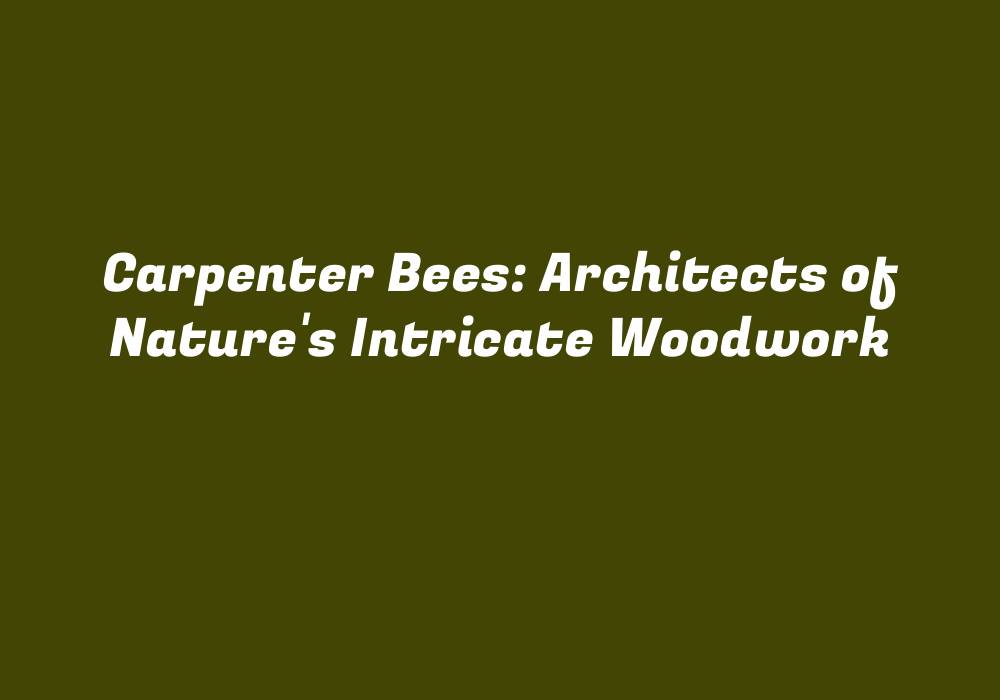Introduction
Carpenter bees are often referred to as “architects of nature’s intricate woodwork.” These remarkable insects construct a series of elaborate tunnels and chambers inside tree trunks, timber structures, and even human-made wooden objects. Their architectural skills make them unique among the numerous species of bees that are known for their pollination activities. Understanding more about these fascinating creatures can lead to better appreciation of their role in maintaining the delicate balance within our ecosystems.
Appearance and Habitat
Carpenter bees come in two primary varieties: the large or Xylocopa carpenter bee (or simply, ‘carpenter bee’) and the smaller Xylocopa virginica (‘Virginia carpenter bee’). The former is known for its preference of burrowing into hardwood trees, while the latter typically prefers softwood species. Both varieties are recognized by their black bodies with yellow or white markings, and the females are larger than their male counterparts.
Carpenter bees inhabit a diverse range of habitats including forests, parks, gardens, and even urban landscapes. They can be found throughout North America, Europe, Asia, and Australia, as well as other regions with suitable environmental conditions. Their preference for woody structures is mainly due to the availability of food sources and their need for nesting sites.
Nesting Behavior and Construction Techniques
Carpenter bees are known to create their nests in a variety of ways. They often burrow into dead or dying tree limbs, where they excavate circular tunnels that lead to multiple individual chambers. These chambers then become the nurseries for their offspring. The females use their strong jaws to bore through wood and excavate the required spaces, while the males primarily serve as protectors of these nests.
Their construction techniques are quite fascinating and can be a valuable source of inspiration in architectural design, especially in terms of resourcefulness and sustainability. Carpenter bees recycle old galleries and tunnels from previous generations for their new broods, showcasing an admirable level of adaptability to changing environmental conditions.
Impact on Human-Made Structures
While carpenter bees primarily focus on the wood structures found in nature, they may occasionally venture into human-made wooden objects as well. This can potentially lead to structural damage and costly repairs, particularly if multiple generations of carpenter bees have used the same area for nesting. These instances can cause concern among homeowners and property managers who are looking to maintain their properties in good condition.
However, it is essential to note that carpenter bees do not directly feed on wood but rather on plant nectar and pollen obtained from flowers. Their preference for nesting in wooden structures simply stems from their natural instincts. It is also worth mentioning that while they can cause harm to human-made objects, these insects play an essential role in pollination and help maintain the health of ecosystems by contributing to biodiversity.
Conservation Efforts for Carpenter Bees
Carpenter bees are not considered a threat or nuisance in most cases, but they may sometimes require intervention when they pose potential harm to human-made structures. In such scenarios, it is advisable to take preventive measures by using appropriate pesticides and repellents that specifically target carpenter bees without harming other insects.
Additionally, there are instances where human activity has significantly disrupted the natural habitat of these remarkable creatures, leading to a decline in their populations. As part of ongoing conservation efforts for native pollinators like carpenter bees, it is important to consider their role in maintaining the balance within ecosystems and take necessary steps to protect their habitats from threats such as deforestation, land development, and climate change.
Conclusion
Carpenter bees are truly architectural marvels of nature. Their remarkable ability to excavate tunnels and chambers within various wood structures is an indication of their importance in maintaining the balance of ecosystems, particularly through pollination. By understanding more about these fascinating insects, we can better appreciate their value and contribute to their conservation efforts that will help ensure their long-term survival.
